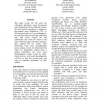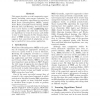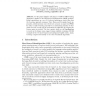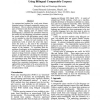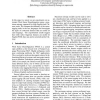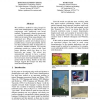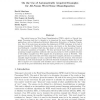ACL
2010
13 years 11 months ago
2010
Word Sense Disambiguation remains one of the most complex problems facing computational linguists to date. In this paper we present a system that combines evidence from a monoling...
CORR
2000
Springer
14 years 1 months ago
2000
Springer
This paper revisits the one sense per collocation hypothesis using fine-grained sense distinctions and two different corpora. We show that the hypothesis is weaker for fine-graine...
CORR
2000
Springer
14 years 1 months ago
2000
Springer
This paper describes a set of comparative experiments, including cross{corpus evaluation, between ve alternative algorithms for supervised Word Sense Disambiguation (WSD), namely ...
CORR
2000
Springer
14 years 1 months ago
2000
Springer
In this paper Schapire and Singer's AdaBoost.MH boosting algorithm is applied to the Word Sense Disambiguation (WSD) problem. Initial experiments on a set of 15 selected polys...
COLING
2002
14 years 1 months ago
2002
In this paper, a supervised learning system of word sense disambiguation is presented. It is based on conditional maximum entropy models. This system acquires the linguistic knowl...
COLING
2002
14 years 1 months ago
2002
An unsupervised method for word sense disambiguation using a bilingual comparable corpus was developed. First, it extracts statistically significant pairs of related words from th...
COLING
2002
14 years 1 months ago
2002
In this paper we report on our experiments on automatic Word Sense Disambiguation using a maximum entropy approach for both English and Chinese verbs. We compare the difficulty of...
CORR
2004
Springer
14 years 1 months ago
2004
Springer
This paper describes the National Research Council (NRC) Word Sense Disambiguation (WSD) system, as applied to the English Lexical Sample (ELS) task in Senseval-3. The NRC system ...
AI
2005
Springer
14 years 1 months ago
2005
Springer
We introduce a method for using images for word sense disambiguation, either alone, or in conjunction with traditional text based methods. The approach is based in recent work on ...
JAIR
2008
14 years 1 months ago
2008
This article focuses on Word Sense Disambiguation (WSD), which is a Natural Language Processing task that is thought to be important for many Language Technology applications, suc...

